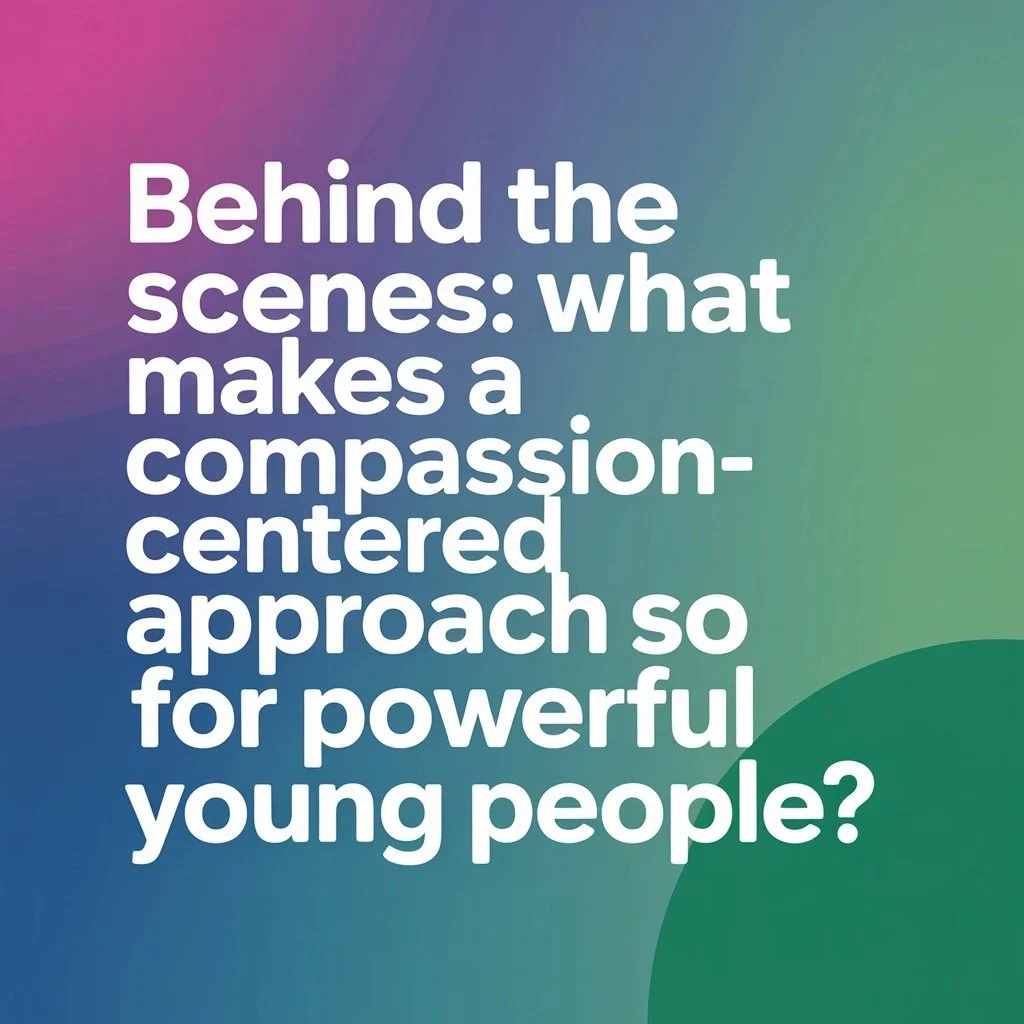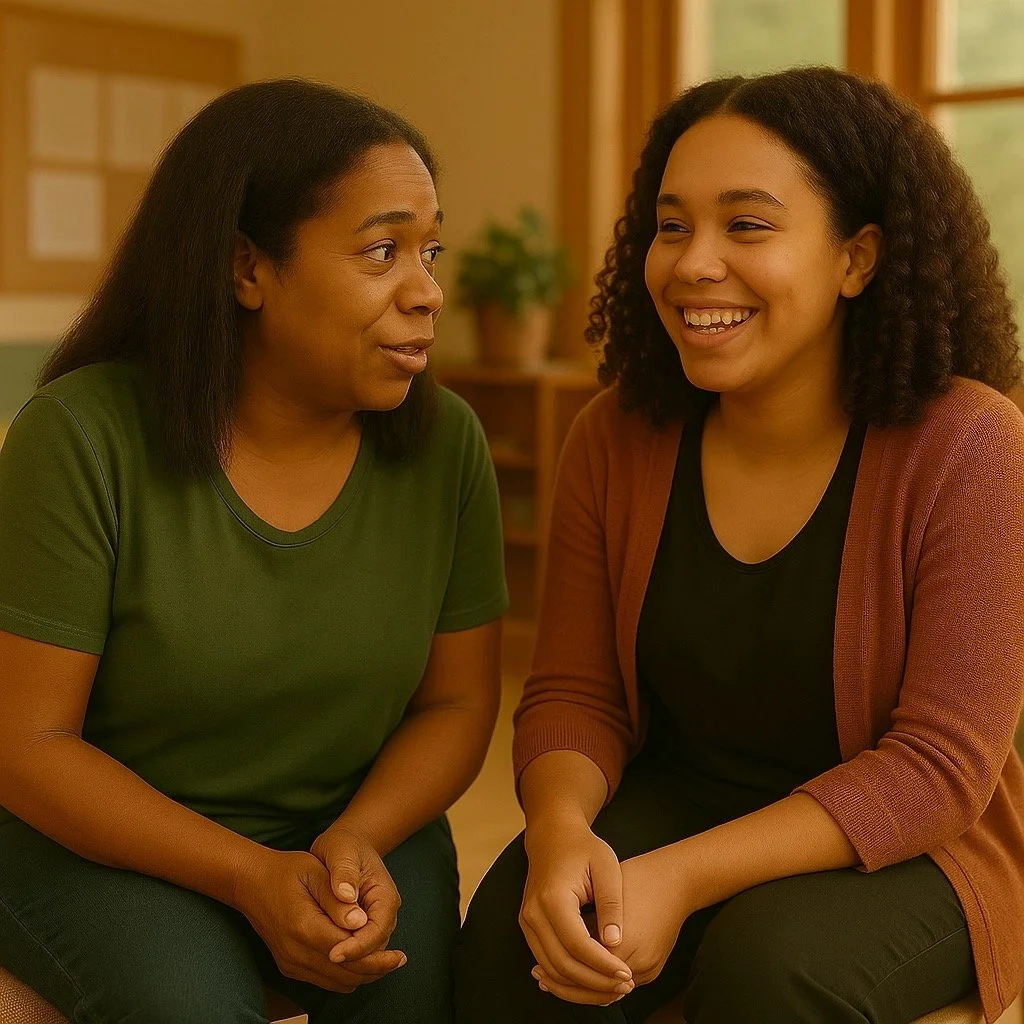A COmpassion-centered approach
The Foundation of Connection
In a world where young people navigate unprecedented challenges, from social media pressures to economic uncertainty, how we approach youth support matters more than ever. At Sana Place Indy, we've witnessed firsthand how compassion transforms lives, but what exactly makes this approach so effective?
Let's pull back the curtain and explore why compassion isn't just a nice sentiment, it's a powerful, evidence-based strategy that creates lasting change for the young people we serve.
What Do We Mean by "Compassion-Centered"?
Before diving deeper, let's clarify what we're talking about. A compassion-centered approach goes beyond simple kindness. It involves:
Intentional presence – Being fully there with young people without judgment
Authentic connection – Creating relationships based on genuine understanding, not authority
Trauma awareness – Recognizing how past experiences shape current behaviors
Empowerment focus – Building resilience rather than dependency
This approach stands in stark contrast to compliance-focused or purely clinical models that sometimes miss the human element at the heart of healing.
The Science: Why Compassion Works for Young Brains
Recent neuroscience research confirms what many youth workers have intuitively known: compassion creates biological changes that support healing and growth.
When young people experience genuine compassion, their brains release oxytocin, often called the "connection hormone", which reduces stress and promotes trust. This is particularly significant because many youth experiencing homelessness or trauma operate in a constant state of fight-or-flight, with elevated cortisol levels that impair decision-making and emotional regulation.
A 2022 study found that compassion-focused interventions significantly reduced symptoms of depression and anxiety in adolescents while improving self-esteem. The research shows these approaches work because they address a fundamental human need for connection that becomes even more crucial during adolescence and young adulthood.
Three Core Elements That Make Compassion Transformative
1. Creating Safety in Uncertainty
For young people facing housing instability or other challenges, life often feels chaotic and unpredictable. Compassion-centered environments provide consistency and psychological safety, essential prerequisites for any meaningful growth.
"When I first came to Sana Place, I was constantly looking over my shoulder," shares one young person who accessed our services. "Having staff who didn't judge me or rush me to 'get better' made all the difference. I could finally breathe enough to think about my future."
This psychological safety isn't about coddling, it's about creating the necessary conditions for young people to engage with difficult emotions and situations from a place of security rather than survival.
2. Modeling What Healthy Relationships Look Like
Many youth we work with have experienced relationships characterized by inconsistency, conditional acceptance, or exploitation. A compassion-centered approach demonstrates what healthy connections look and feel like.
When staff maintain boundaries while showing unconditional positive regard, young people learn through direct experience that relationships can be supportive without being transactional. This modeling happens through countless daily interactions, from respecting privacy to honoring preferences to following through on commitments.
The impact extends beyond the immediate relationship. As young people internalize these experiences, they become more capable of forming healthy connections in other areas of their lives.
3. Shifting from "What's Wrong?" to "What Happened?"
Traditional approaches often begin by identifying deficits, diagnosing problems, or categorizing behaviors. Compassion-centered work starts differently by asking: "What happened to you?" rather than "What's wrong with you?"
This subtle shift recognizes that challenging behaviors or struggles are often adaptive responses to difficult circumstances, not character flaws or pathologies.
"When people look at homeless youth, they see problems to fix," explains a member of our team. "When we lead with compassion, we see young people with incredible resilience who've survived situations most adults couldn't imagine. That perspective changes everything about how we work together."
Breaking Through Resistance and Building Trust
One of the most powerful aspects of compassion-centered approaches is their effectiveness with young people who've been resistant to traditional services.
Many youth arrive at our doors after negative experiences with systems designed to help them. They've learned to be guarded, skeptical, and sometimes outright resistant—with good reason. These are protective strategies that have helped them survive.
Compassion works where other approaches fail because it doesn't demand trust upfront. Instead, it earns trust gradually through consistency, respect, and authentic care. This is especially important for young men, who often face cultural expectations to handle problems independently and may view seeking help as a sign of weakness.
"I didn't want anything to do with another program," one young man told us. "But this felt different from day one. No one was trying to 'fix' me or tell me how to live. They just showed up, consistently, even when I wasn't at my best."
How Compassion Addresses Unique Developmental Needs
Young adulthood is a distinct developmental stage with specific psychological needs. Compassion-centered approaches are uniquely suited to address these needs because they:
Honor autonomy while providing support
Recognize identity exploration as essential work, not a distraction
Accept non-linear progress rather than expecting continuous improvement
Validate emotional experiences without minimizing or amplifying them
This developmental alignment explains why compassion-centered approaches resonate so deeply with young people. They feel seen and respected in their journey rather than processed through a system.
The Ripple Effect: Beyond Individual Impact
The power of compassion extends beyond individual healing. When young people experience compassion-centered support, it creates a ripple effect:
Peer influence: Young people begin modeling compassionate approaches with each other, creating positive community norms.
Future relationships: As they internalize healthy relationship patterns, they bring these forward into their romantic, familial, and professional relationships.
Community connection: Young people who feel genuinely cared for are more likely to develop their own sense of care for the broader community.
At Sana Place Indy, we see this ripple effect in action when former participants return as volunteers, mentors, or advocates—demonstrating how compassion received becomes compassion shared.
Challenges and Misconceptions About Compassion-Centered Work
Despite its effectiveness, compassion-centered work faces misunderstandings:
Misconception #1: "Compassion means no boundaries or consequences."
Reality: Authentic compassion includes clear, consistent boundaries. In fact, maintaining appropriate boundaries is itself an act of compassion that helps young people develop healthy expectations of relationships.
Misconception #2: "It's too 'soft' an approach for 'tough' cases."
Reality: Compassion requires tremendous courage and resilience from staff, especially when working with young people who test relationships through challenging behaviors. It's often the most demanding approach, requiring staff to regulate their own reactions while staying connected.
Misconception #3: "It's just being nice."
Reality: Compassion-centered work is strategic and intentional, grounded in understanding trauma, attachment, and neurodevelopment. It's not about being nice, it's about being effective.
Implementing Compassion in Your Interactions with Young People
While formal training in trauma-informed, compassion-centered approaches is valuable, anyone can begin incorporating these principles:
Practice genuine curiosity instead of making assumptions
Validate emotions even when you can't validate actions
Offer choices whenever possible to restore a sense of control
Acknowledge efforts, not just outcomes
Separate the person from their behavior with language like "I care about you, and this behavior isn't acceptable" rather than "You're being unacceptable"
These practices create connections that support growth, whether you're a parent, educator, youth worker, or community member.
The Long View: Why Compassion Creates Sustainable Change
Traditional compliance-focused approaches might produce quicker surface-level results, but compassion-centered work creates deeper, more sustainable change. Why? Because it addresses root causes rather than symptoms.
When young people develop internal resources through compassionate relationships, they build resilience that extends far beyond any program. They don't just follow rules while being monitored, they develop the self-awareness, emotional regulation, and relationship skills needed for long-term stability and growth.
Join Us in This Approach
At Sana Place Indy, compassion isn't just what we do, it's who we are. We've seen it transform lives, rebuild trust, and create pathways to healing that seemed impossible.
If you're interested in supporting or learning more about compassion-centered approaches to youth support:
Consider volunteering with us to experience this approach firsthand
Attend one of our community workshops on trauma-informed, compassion-centered care
Support our work through donations that allow us to maintain low barriers to access
Share this perspective with others working with young people in your community
The beauty of compassion is that it's both profoundly simple and endlessly complex. It begins with the fundamental recognition of human dignity and worth, then extends into sophisticated practices that honor each person's unique journey.
For the young people we serve, this approach isn't just nice to have, it's the difference between a program that processes them and a community that transforms with them.
If you'd like to learn more about our compassion-centered approach or get involved with our work, visit our website or reach out directly through our contact page.





